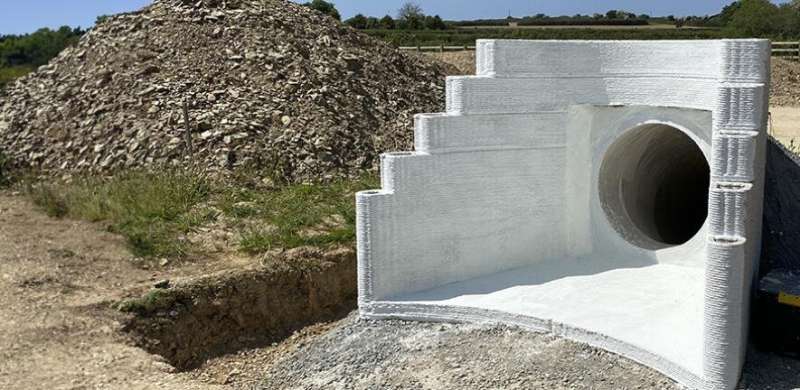This article has been reviewed according to Science X's editorial process and policies. Editors have highlighted the following attributes while ensuring the content's credibility:
fact-checked
trusted source
proofread
Cambridge researchers help develop smart, 3D printed concrete wall for National Highways project

Cambridge researchers, working in partnership with industry, have helped develop the first 3D-printed piece of concrete infrastructure to be used on a National Highways project.
The 3D-printed structure—a type of retaining wall known as a headwall—has been installed on the A30 in Cornwall, where it is providing real-time information thanks to Cambridge-designed sensors embedded in its structure. The sensors provide up-to-date measurements including temperature, strain and pressure. This 'digital twin' of the wall could help spot and correct faults before they occur.
Headwall structures are normally made in limited shapes from precast concrete, requiring formwork and extensive steel reinforcement. But by using 3D printing, the team—including specialists from Costain, Jacobs and Versarien—could design and construct a curved hollow wall with no formwork and no steel reinforcement. The wall gets its strength not from steel, but from geometry instead.
The wall—which took one hour to print—is roughly two meters high and three and a half meters across. It was printed in Gloucestershire at the headquarters of the advanced engineering company Versarien, using a robot arm-based concrete printer. Making the wall using 3D printing significantly saves on costs, materials and carbon emissions.
Over the past six years, Professor Abir Al-Tabbaa's team in the Department of Engineering has been developing new sensor technologies and exploring the effectiveness of existing commercial sensors to get better-quality information out of infrastructure. Her team has also developed various 'smart' self-healing concretes. For this project, they supplied sensors to measure temperature during the printing process.
Temperature variations at different layers of the 3D-printed wall were continuously monitored to detect any potential hotspots, thermal gradients, or anomalies. The temperature data will be correlated with the corresponding thermal imaging profile to understand the thermal behavior of the 3D-printed wall.
"Since you need an extremely fast-setting cement for 3D printing, it also generates an enormous amount of heat," said Al-Tabbaa. "We embedded our sensors in the wall to measure temperature during construction, and now we're getting data from them while the wall is on site."
In addition to temperature, the sensors measure relative humidity, pressure, strain, electrical resistivity, and electrochemical potential. The measurements provide valuable insights into the reliability, robustness, accuracy, and longevity of the sensors.
A LiDAR system also was used to scan the wall as it was being printed to create a 3D point cloud and generate a digital twin of the wall.
"Making the wall digital means it can speak for itself," said Al-Tabbaa. "And we can use our sensors to understand these 3D printed structures better and accelerate their acceptance in industry."
The Cambridge team developed a type of sensor, known as a PZT (Piezoceramic Lead-Zirconate-Titanate) sensor, which measures electromechanical impedance response and monitors changes in these measurements over time to detect any possible damage. These smart sensors can show how 3D-printed mortar hardens over time, while simultaneously monitoring the host structure's health.
Eight PZT sensors were embedded within the wall layers at different positions during the 3D printing process to capture the presence of loading and strain, both during the construction process and service life after field installation.
The team, which included experts in smart materials, automation and robotics and data science, also developed a bespoke wireless data acquisition system. This enabled the collection of the multifrequency electromechanical response data of the embedded sensors remotely from Cambridge.
"This project will serve as a living laboratory, generating valuable data over its lifespan," said Al-Tabbaa. "The sensor data and 'digital twin' will help infrastructure professionals better understand how 3D printing can be used and tailored to print larger and more complex cement-based materials for the strategic road network."
Members of the team included Dr. Sripriya Rengaraju, Dr. Christos Vlachakis, Dr. Yen-Fang Su, Dr. Damian Palin, Dr. Hussam Taha, Dr. Richard Anvo and Dr. Lilia Potseluyko from Cambridge; as well as Costain's Head of Materials Bhav Ramrakhyani, a part-time Ph.D. student in the Department of Engineering, and Ben Harries, Architectural Innovation Lead at Versarien, who is also starting a part-time Ph.D. in the Department of Engineering in October.




















